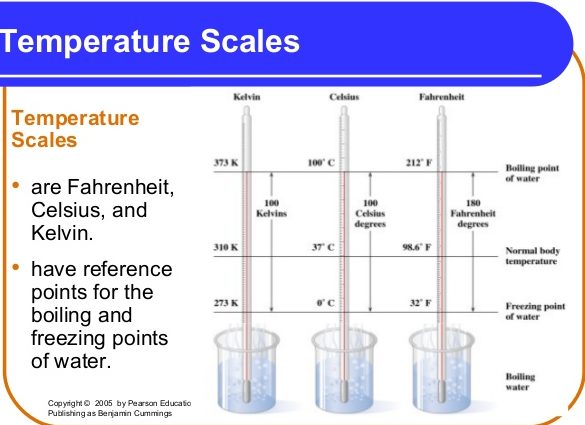Back to: PHYSICS SS1
Welcome to class!
In today’s class, we will be talking about the concept of heat. Enjoy the class!
Concept of Heat

What is heat energy?
Heat is energy in motion between two points because of the temperature difference between them. If there is no temperature difference, there will be no transfer of energy (i.e. heat). Heat is measured in joules (J) and it is named after James Prescott Joules (1819 – 1889).
Heat has other multiple units, as shown in the table below:
| Multiple units | Sub – multiple units |
| Kilojoules (103J) | Millijoules (10-3J) |
| Megajoules (106J) | Microjoules (10-6J) |
| Gigajoules (109J) | Nanojoules (10-9J) |
| Terajoules (1012J) | Picojoules (10-12J) |
Effect of heat energy
When heat energy is supplied to a substance it produces different effects on the substance. Some common effects of heat are:
- Rise in temperature
- Thermal expansion
- Change of state
- Chemical reaction
- Thermionic emission
- Emission of light
Rise in temperature
The temperature of a body will increase when heat is applied to the body. However, the rise in temperature depends on:
(i) The amount of heat present
(ii) The mass of the body
(iii) The nature of the body.
Thus, if the same amount of heat is supplied to water in a kettle and water in a bucket, for the same time interval, the water in the kettle appears hotter. This is because it has a smaller mass than the water in the bucket.
Thermal Expansion
Most substances (whether solid, liquid or gas) expand when heated and contracts when their temperature falls. Thermal expansion of solids can be demonstrated using the ball and ring apparatus.

Change of state:
Matter exist s in three states as Solid, Liquid and Gas. The state in which a given substance exists depends on the temperature of the substance. A change of the temperature can make a substance change from one state to another. For example, water exists as ice (solid) at a temperature below 0°C. At 0°C, the ice begins to melt into water (liquid) while the temperature remains constant. Because the heat supplied to the ice during the process of melting does not alter (increase) the temperature, it is called the latent heat of fusion. Latent means “hidden”.
Chemical reaction:
Heat can cause some chemical reactions. For instance, the colour (paint) of a car changes with time on exposure to changing weather conditions.
Thermionic emission:
Metal surfaces emit electrons when heated. This phenomenon is made use of in the cathode ray tube of our T.V set.
Emission of light:
Most solids, particularly metals, emit light when heated to a very heat temperature. If you observe a blacksmith at work, a heated metal becomes red hot. As the temperature is increased it becomes white-hot and produces light (it glows). This is made use of in our electric bulb. The current through the filament makes it hot until it becomes white-hot and glows.
Temperature and its Measurement
Meaning of temperature
We stated earlier that the addition of heat to a body will increase the temperature of the body. What we mean by this is that the degree of hotness of the body will increase. Hence, temperature expresses how hot or cold a body is. It is a number which shows the degree of hotness or coldness of a body on a specified scale of measurement.
We also stated earlier on, that temperature determines which way heat will flow between two bodies when they are in contact. Heat normally flows from a body at a higher temperature to that at a lower temperature; there will be no heat exchange between two bodies if both have the same temperature.
Temperature is a measure of the average kinetic energy of the molecules of a substance.
Temperature scales
It is measured with reference to some chosen fixed temperatures. These are known as fixed points. The interval between the fixed points is then divided into equal parts. The most common temperature scales are:
- Celsius scale
- Kelvin scale
- Fahrenheit scale

The Fahrenheit scale is old and no longer in use for scientific purposes. The two fixed points referred to above are called upper and lower fixed point. The upper fixed point is the temperature of steam from boiling water while the lower fixed point is the temperature of pure melting ice.
On Celsius scale, the lower fixed point is 0°C and the upper fixed point is 100°C at normal pressure, however, the lower fixed point corresponds to 273K while the upper fixed point is 373K on Kelvin scale. Hence in both Celsius and Kelvin scales the interval between the lower and upper fixed point is the same (100 divisions).
On the Fahrenheit scale, however, the lower fixed point is 32°F, while the upper fixed point is 212°F. That is, the interval between them is 180 unlike the Kelvin and the Celsius scale. It must be noted that the absolute or Kelvin scale is used as the SI unit of temperature. The zero on this scale corresponds to 273°C on the Celsius scale. This temperature is called absolute zero scale because no temperature can be lower than it. That is, absolute zero is the lowest possible temperature.
Scale conversions
(1) To convert from Celsius to Kelvin
Tk = Tc + 273
(2) To convert from Kelvin to Celsius
Tc = Tk – 273
(3) To convert from Celsius to Fahrenheit
Tf = (32 + Tc)
(4) To convert from Fahrenheit to Kelvin
Tc = (Tf – 32)
Examples
Convert each of the following temperatures from the scale given to that indicated:
(i) 20°C to Kelvin
(ii) 303 Kelvin to Celsius
(iii) 35°C to Fahrenheit
(iv) 95°F to Kelvin
Solution
(1) Tk = Tc + 273
Given Tc = 20° while Tk = unknown
Tk= 20 + 273 = 293K
(2) Tc = Tk – 273
Given Tk = 303 while Tc = unknown
Tc= 303 – 273
= 30°C
(3) Tf = (32 + Tc)
Given Tc = 35°C while Tf = unknown
Tf= (32 + x 35)
= (32 + 63)
= 95°F
(4) Tc = (Tf – 32)
Given Tf = 95°F while Tc = unknown
Tc= (95 – 32)
= (63)
= 35°C
Comparison between temperature and heat
| S/No | Temperature | Heat |
| 1 | This is the degree of coldness or hotness of a body | This is the quantity of energy in a body. It is a form of energy |
| 2 | It is a measure of the average energy of the molecule of the substance | It is a measure of the total energy of the substance |
| 3 | It is measured using a thermometer | It is measured using a calorimeter |
| 4 | It is measured in Kelvin, K | It is measured in Joule, J |
Similarities
- They are both scalar quantity
- Energy is involved in both cases.
In our next class, we will be talking about the Thermometer. We hope you enjoyed the class.
Should you have any further question, feel free to ask in the comment section below and trust us to respond as soon as possible.

how did you get 32 in the last question
It in the formula
how did you get 35 in the last question
Please can anyone help me with the number three example
I don’t understand (32+×35)
Please I dont understand that celsius scale to fahreint scale
ok